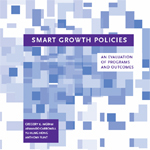September 29, 2009 Categories: Reviews
Smart Growth Policies: An Evaluation of Programs and Outcomes
Gregory K. Ingram, Armando Carbonell, Yu-Hung Hong, and Anthony Flint
2009. Lincoln Institute of Land Policy. 275 pp. $35.
The 22 contributors to this book compare and contrast four states that have statewide smart-growth programs (Florida, Maryland, New Jersey, and Oregon) with four that do not (Colorado, Indiana, Texas, and Virginia). This could be a tricky enterprise, given that New Jersey’s court-mandated affordable-housing requirements, Florida’s process-oriented planning, and Oregon’s long-term planning to concentrate urban growth are hardly peas in a pod. Similarly, Colorado’s local smart-growth activism contrasts strongly with Indiana’s lack of interest at all governmental levels.

The authors seek to measure the eight states against what they identify as the five general objectives of smart growth: compact development, environmental quality, transportation variety, affordable housing, and positive fiscal impacts. Mostly they evaluate the 1990s, although there is some information from the 1980s and early 2000s. The heart of the book consists of these comparisons, but eight extra chapters zero in on each of the eight focus states.
The authors’ verdict is given in the preface: “No state did well on all smart growth principles.” {ix} In general, states did not hit what they did not aim at. Furthermore, the five objectives seemed to play against each other, at least in practice and perhaps in principle. From 1990 to 2000, Oregon increased transit’s share of commuting from 10 to 12 percent in its high-density county, and by lesser amounts in nine other counties — at a time when US averages were declining across the board. Oregon was also the only state to increase its share of walking and bicycling commuters in the decade. {62, 63} But at the same time, housing in the state became significantly less affordable for both owners and renters. {86} Whether these objectives are inherently in tension, or whether they’re both so much against the grain that both need full attention, is not discussed.
Some of the confusion in antisprawl rhetoric is reflected in this scholarly treatment. The authors use a “Gini coefficient” to measure dispersion of growth. But in practice, they acknowledge that “the optimal concentration of people and jobs is difficult to define in cities with multiple centers of activity and relatively dense development around those centers.” {28} As often the case, it’s easier to tell what you’re against than what you’re for.
And even when you know what you’re for, it would seem that policy makes only a marginal difference. “Despite large differences in population growth, the rankings of the eight states in terms of developed land per capita did not change over the 15 years. This suggests that development densities are determined by large-scale regional and state-specific factors and do not vary significantly over time.” {28}
Similarly in transportation: smart-growth programs “work at the margin, successfully increasing transit commute shares and reducing the growth in commute times, but making only modest dents in the larger trend toward increased automotive travel.” {74} In other words, don’t try to sell smart growth as a cure for traffic congestion — or for global warming — on any time scale shorter than decades. One does get the feeling that policymakers, as opposed to designers, are having to try to put together a delicate machine wearing mittens.
Of particular interest to Notre Dame readers will be the chapter on Indiana by Eric D. Kelly of Ball State University. It is not pleasant reading. The state does have a 1981 law that “implies that a county with large rural areas might specify that subdivision cannot occur in some rural or agricultural zoning districts, thus creating an effective tool to manage growth patterns.” {218} However, nobody seems to have noticed. Even though Indiana was the slowest-growing of the eight states examined, it “ranked first for having the most new development occur outside existing urbanized areas” — 94 percent during the 1990s, compared with 52 percent in Oregon. While discussing the contributions of other universities, Kelly mentions Notre Dame not at all — neither as an institutional factor in the development of Indiana’s fourth-largest city, nor as an intellectual factor in championing new designs or ways of thinking about cities.
#
